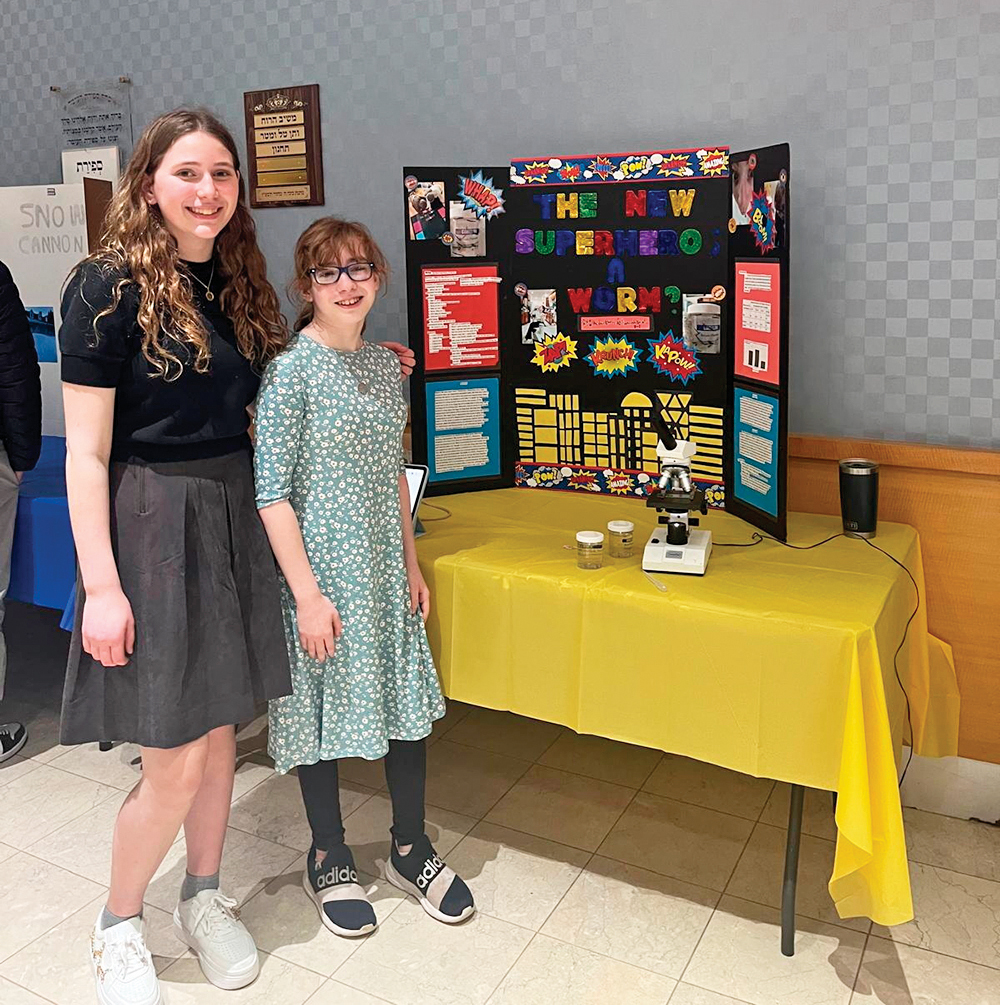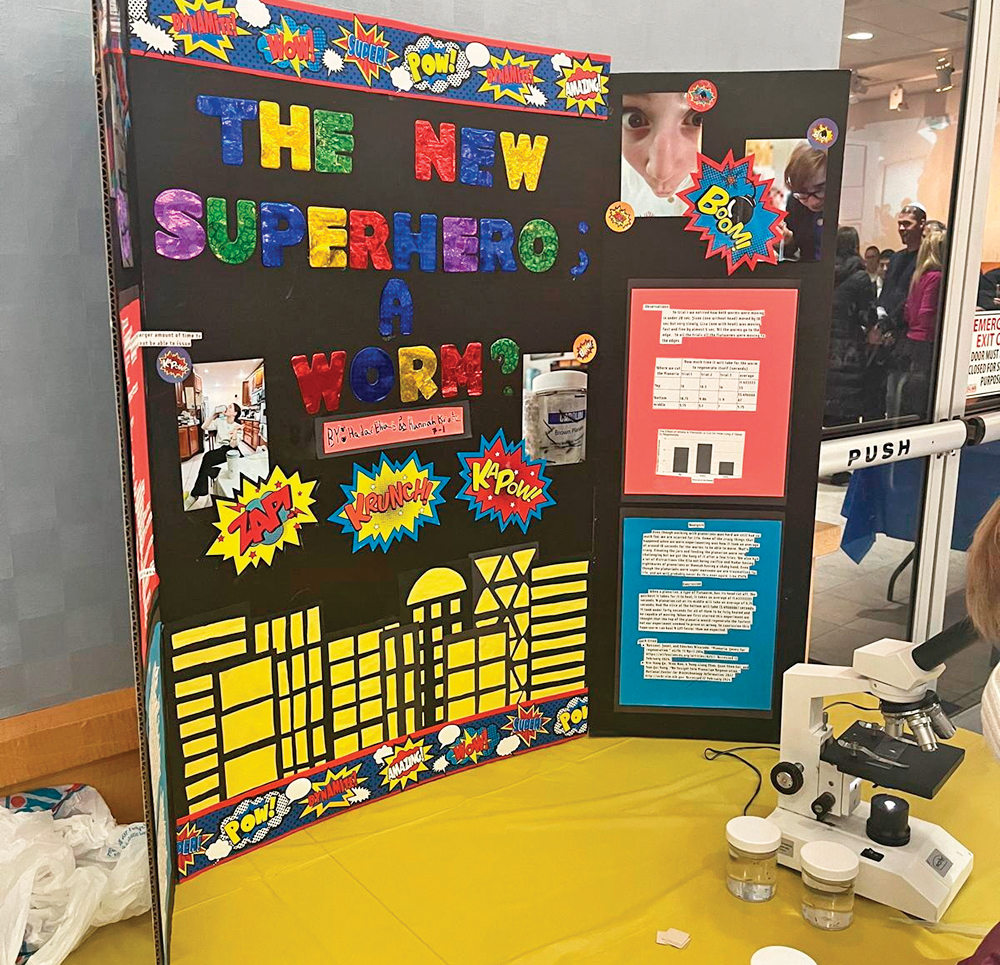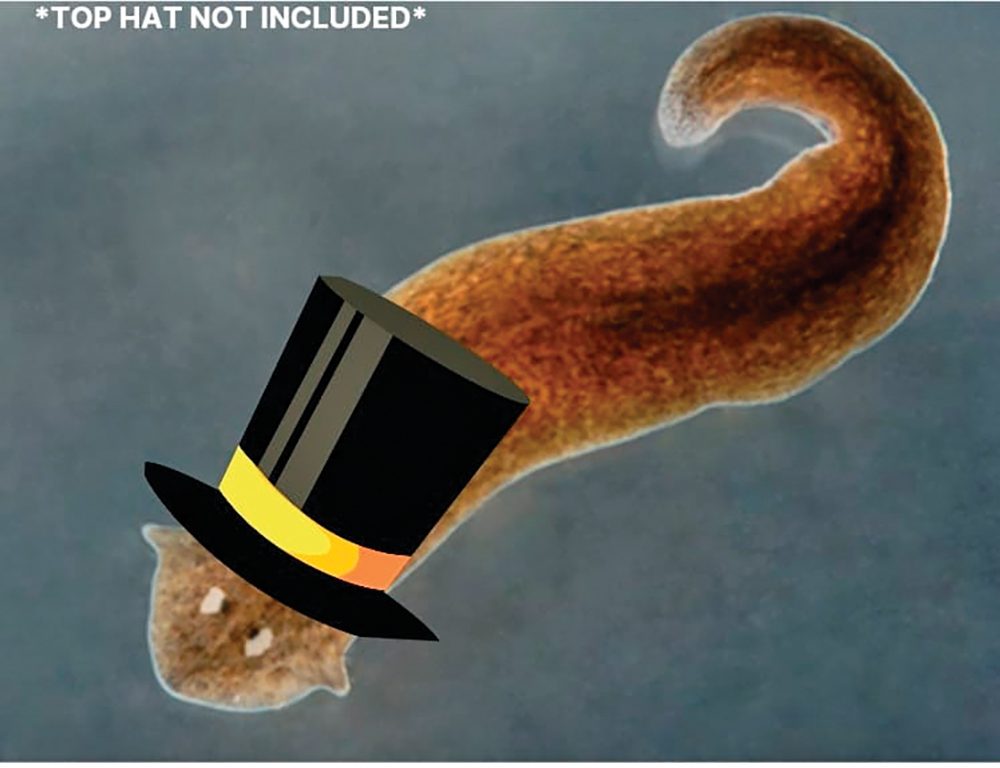
A big annual seventh-grade general studies project at the Moriah School is Science Fair. When discussing potential topics, Hannah Kratz’s tutor Patti London recollected an amazing animal that her brother studied for his science fair decades ago. Hannah and fellow student Hadar Elias decided to do a different project about the same animals, “and it turned out to be way more awesome than we imagined,” they said. “But it presented some difficulties as well, as dealing with a lot of live animals was something we’d never done before.” This is their story.
Hannah: The project was on the planarian, or planaria (plural). What are these marvelous creatures? What can these amazing triclads do? Planaria, quite simply, are a type of freshwater flatworm with a triangular head that cannot be killed. The biggest ones we had were around an inch long and quite narrow; less than an eighth of an inch wide. If you cut out a part of it the planaria will simply regrow that part. Cut off their head they can implant their memories on another body. Cut them in two and you get two worms. Scientists still don’t know how they regrow specific organs. After our extensive research over the past few months, we feel confident to explain all the wonders of this superworm to you.

My partner Hadar, who is still getting nightmares from these worms, is new to the world of fame (which I have developed in The Jewish Link as the author of the Kid’s Link Superfan of the Month, a job I got through nepotism) and will accompany me in explaining the wonders of this special flatworm.
Hannah and Hadar: A planarian, in short, is a worm. A flatworm. Most worms in general don’t really seem to do much. They move around in mud, you can cut them up and they become two, but that’s really all there is. A planarian is similar to a worm in multiple ways (because it is one), but to focus on the part of cutting up worms, the planarian is really special.
What can we hope to learn by studying these interesting triclads? That’s pretty much our main question, and to answer it is simple. We want to be immortal. No (Yes). Haha. Scientists study planaria to help human cells learn to regenerate injured or missing skin. They also give important information for the ecosystem, such as the fact that they help us determine if water is fresh or of good quality. Normally most flatworms are bad for the ecosystem, but planaria keep away these other invasive worms. So as you can see, they are pretty impressive.
What causes planaria to regenerate? What gives them their amazing superpowers? The answer to that is … neoblasts. Neoblasts are stem cells that are distributed throughout the body when the planarian is cut. They can actually heal and remake the part that has been cut, though it is still not fully clear how they can regenerate specific organs; scientists are still researching this. Before we can answer that question we need to really understand what a planarian is. If you don’t understand, this means that they are immortal. Or really just immortal under a knife (and immune to aging). So pretty much virtually immortal. Except in your care—then they might die right away. It depends.

By the time you’ve gotten halfway through this article, you might be wondering about our story or connection with these worms. Patti shared about the topic with Hannah and then Hannah told (forced down her throat) the idea to Hadar. We decided to just go for it, so that was what happened.
We eventually got into some trouble over where we would put these planaria, after Hannah’s mother, Elizabeth Kratz—yes, the editor of the paper you are reading—told us we could no longer keep our pals on the kitchen table (where they had been residing for two months at that point) as no one had been eating there except Hannah for the last few months. Luckily, the sixth-grade science teacher at Moriah graciously allowed us to keep our planaria in her class, much to the dismay of some of her students. If you would like to adopt some for free, keep reading, for in the next paragraph we will give a detailed illustration of their care.
It was said on the research site where we bought them, Carolina Biological Sciences, that in our care the planaria would be dead in one to three days. Since we bought them in February and it’s now May, you can see this was not the case. (Multiple of them still died, but we deduced this was probably out of embarrassment, as we named them all “Fluffy.”)
Of all things, we’ve decided the reason so many just refuse to die is because of our simply amazing care for them. We clean their jars about once every two weeks, often with the help of our friend Ora Eichenwald, and feed them a small amount of boiled egg yolk then too, and that seems to work out pretty well. In the case that you do take up our offer and adopt a planarian and take care of them, but in the end you just realize that you don’t actually want the commitment, you can’t throw them away. If you did, they wouldn’t just magically disappear. The only way to dispose of this creature is to boil them or freeze them. We don’t recommend it.
In conclusion, we hope that we have imparted some common sense and an unknown, mysterious desire to learn more about these worms, and possibly adopt one of your own. You are most certainly welcome. Anyway, the point of this article is to ask our readers to rescue us from this burden and take some new pets from us. Please. We beg you. And now we both have successfully swayed to join the Planarian Fan Club™. Maybe you’ll even consider taking one or more of these wonderful planaria off our hands. Just don’t tell your parents so many details. What they don’t know can’t hurt them. Thank you, and good luck.

Warning: Your planaria might be dead.
Warning: Your planaria might be smaller than expected.
Warning: The planaria might make your sister mad at you.
Warning: You might hallucinate that they are climbing on your arm in the shower.
Warning: It is illegal to throw out or release them because they are an invasive species not local to us, so they could kill the entire ecosystem. But no pressure.
Warning: Makes a perfect gift for science teachers or students.
Hadar Elias goes to the Moriah School of Englewood, and loves stealing Hannah’s ketchup and decoding Taylor Swift lyrics. If you ever need a friend or want to sing some Taylor Swift songs, email [email protected].
Hannah Kratz, better known as Hannah the Great, goes to the Moriah School and would appreciate it if you sent her ketchup. If you email [email protected], she will interview you as the kid’s link superfan of the month.









